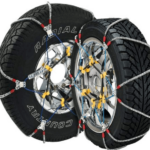It can be a challenge to drive during rough weather like rain and hail. Driving in snow or on ice can be dangerous. The low visibility and slippery roads make it important to know how to safely drive in the snow. How to drive in snow?
When driving in the snow, it is important to be smooth with the steering wheel, brakes, and accelerator. You should also look far ahead to anticipate turns in the road or oncoming vehicles.
Traffic accidents during snowfalls injure about 76,000 people every year, and about 70% of accidental fatalities during winter involve cars. So it is more difficult to drive in the snow and requires more caution.
In this article, we’ll discuss the following 9 safety tips for driving in the snow:
- Prep Your Car for Winter Roads
- Prepare an Emergency Supply Kit for Your Car
- Plan Your Drive
- Install Winter Tires or Snow Tires
- Maintain a Clear Vision
- Check Your Tailpipe
- Drive Slow and Steady
- Use Your Brakes Smartly
- Balancing Your Momentum Is Key
Read on to know how to drive in snow and on ice for seamless and safe navigation through slippery roads.
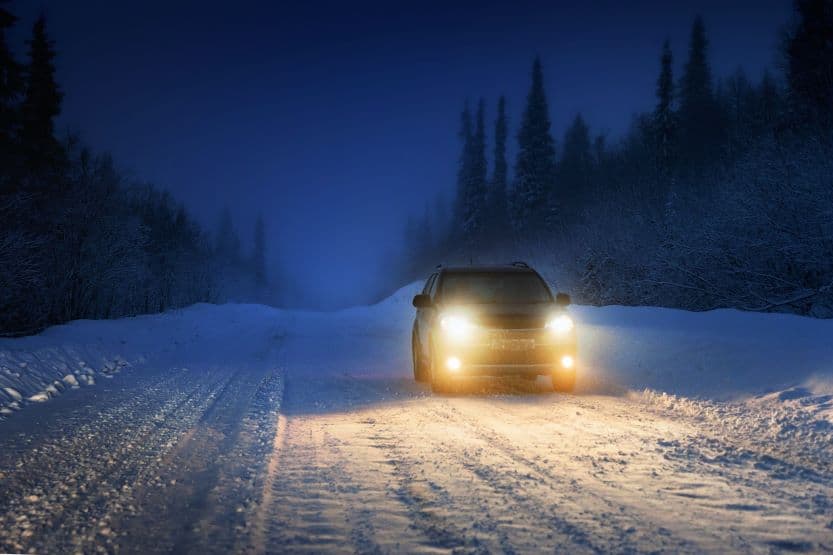
How to Drive in Snow?
When driving in the snow, it is important to be smooth with the steering wheel, brakes, and accelerator. You should also look far ahead to anticipate turns in the road or oncoming vehicles.
Ice and snow on the roads significantly reduce the traction you have, making it more difficult to move along the roads, steer and even stop. Visibility may also be impacted because winter months bring lesser daylight hours coupled with the foggy atmosphere.
Safety measures are in place on all roads, both urban and rural areas, but you must never be complacent. It is better to err on the side of caution when driving, especially during wintertime. But how to drive in snow depends just as much on the preparedness of your car as it does on your driving skills.
How to drive in snow with front-wheel drive or rear-wheel drive? To safely drive in the snow, follow the below 9 key preparation and driving tips:
1. Prep Your Car for Winter Roads
The first step for how to drive in ice and snow is to prep your car for the road. You already subscribe to the annual maintenance of your car, but the basic checkup is not enough when we are talking about driving in snow. Here are some tips from The National Safety Council (NSC) to really make sure your car is prepared for particularly slippery and icy roads:
- Test your battery as the temperature drops with the cooler weather, so does your battery power.
- Check if your cooling system is in good working condition.
- Avoid a gas line freeze by always keeping your gas tank at least half-full.
- Have winter tires installed for extra security as winter tires have a more flexible and deeper tread
- If you have “all-season tires,” make sure the tread is never less than 2/32 of an inch, or else it is best to replace them before using your car on winter roads.
- Make sure your wiper blades are in excellent shape.
- Add more wiper fluid rated for -30 degrees.
The NSC recommends keeping updated with an emergency preparedness kit in your car. Much like a “Go-bag,” this kit should always be fully stocked so you can be prepared for almost any emergency you may encounter on the road.
2. Prepare an Emergency Supply Kit for Your Car
Emergency supply kits in cars must contain essentials not just for your car but also for you. Contents must be checked every six months so you can update and replace expired items. Items inside your kit must include:
For Your Car
- Spare tire – properly inflated
- Wheel wrench, tripod jack, jumper cables
- Multipurpose utility tool
- Flashlight (with extra batteries)
- Reflective triangles & bright cloth
- Compass
- Fire extinguisher
- Duct tape
For You
- Drinking water
- Non-perishable, high-energy snacks (i.e., dried fruits, unsalted nuts, hard candies)
- Car charger for your mobile phone and gadgets
- Reflective vest (in case you need to walk to get help)
- Raincoat
- Keep a record in your mobile phone: contact numbers for the auto insurance provider, towing company, your family, and emergency services
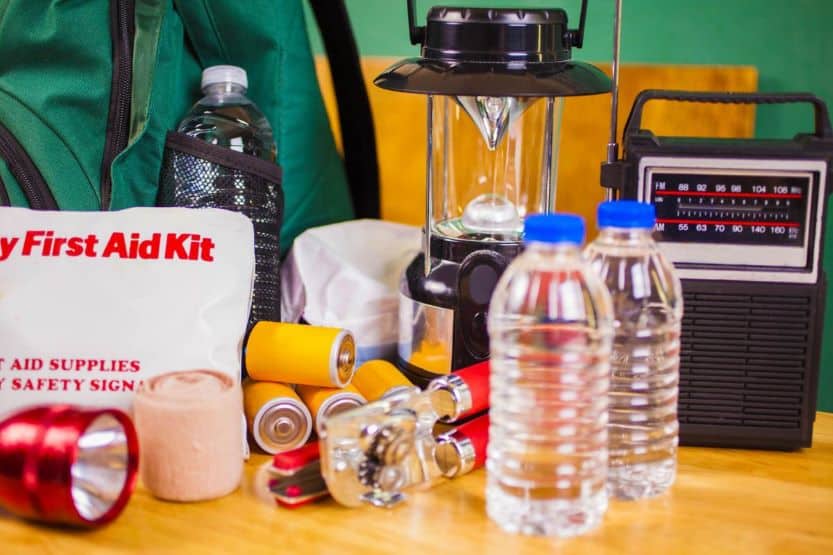
Other additional items that may be of use during colder weather include a shovel, snow brush, cat litter for traction, windshield washer fluid, extra warm clothing, and blankets. With your emergency supply kit, you can be sure to be extra safe and secure when you are out driving during the snow.
3. Plan Your Drive
The next step for how to drive in the snow safely is to plan your drive. Now that you have prepped your car and emergency kit, you have to plan for your trip no matter how close or far you will be driving. Assess whether the trip is important enough or if it can wait until sunnier weather. Remember, only drive if you completely have to. You may be experienced in driving during snowfall, but other drivers may not be equipped enough to avoid a possible collision.
If you absolutely have to drive, be sure to have everything you need before going. It is best if you let someone know of your plans before heading out so they know when they can expect you to be back. This is especially important to those living in rural areas.
If you have to bring your pet, do not forget to prepare food, water, and blankets for them as well. Aside from the emergency kit we mentioned above, it might be a good idea to bring a piece of board. This is useful as a dry spot when you need to kneel, like installing tire chains or something.
4. Install Winter Tires or Snow Tires
As part of your car prep work, a good idea for a safer drive in snow is to have winter tires or snow tires installed in your car, especially if you live in an area where freezing temperatures, ice, and snow are fairly common. These tires are designed specifically for harsh winter weather where there is less traction due to the slippery roads.
The best quality winter tires are equipped with rubber compounds and treads that are designed for maximum grip in snowy weather. The rubber formulation is used to stay flexible in the cold. It also provides a better grip when the roads are dry. Crisp, biting edges in the tread designs help create and maintain the level of traction needed to drive in snow.
Read on to learn the other step and tips for how to drive in the snow and how to drive on ice? These tips will let you drive confidently for your next trip.
5. Maintain a Clear Vision
Another tip you can follow for how to drive in snow and ice is that before you set off on your snowy trail, make sure you clear off the snow and ice from your roof and windows.
Driving a snow-covered vehicle is not only dangerous; it is also illegal in most states. If you do not clear out the snow on the roof of your car, the snow can slide down the windshield while you are driving, blocking your vision. It can be blown off onto the windshields of cars next to you as you drive by.
It is best to keep a handy snow brush or ice scraper in your car to make it easy to remove snow or ice when needed. While you are at it, be sure to scrape off any snow covering your headlights and taillights to ensure you will be seen by other cars on the road, and you can see what’s in front at all times.
And no matter how in a rush you are, never pour hot water on a window to clear any ice or snow. Any chips or cracks on your windows can easily expand due to the temperature change and may result in damage to your car or an injury to you.
6. Check Your Tailpipe
The next step for how to drive safely in snow is to check your tailpipe. This is something a lot of drivers forget to do. Checking on your tailpipe, especially when your car has been stuck in the driveway all night during a snowstorm, is vital.
You have to clear your tailpipe/s out of any snow, ice, or debris before even trying to start your car. If your exhaust is clogged, you run the risk of carbon monoxide gas seeping into your car’s cabin, poisoning you.
7. Drive Slow and Steady
How to drive on ice is much like how you drove the first time you took the test to get your driver’s license – very carefully. It takes patience and excellent control when it comes to driving on slippery roads. Think of it as if you have fragile eggs under the pedals that will break if you push too fast or too hard.
Driving slow and steady will also aid your tires in maintaining a grip on the road. Driving too fast may result in your car skidding, spinning, or worse, a collision with another vehicle. The trick is to anticipate the trail you are driving on, look ahead for stops, humps, and corners and adjust your momentum early on.
Another thing to note is NEVER to use cruise control when driving in snow. You need to be fully engaged behind the wheel when driving in winter conditions, especially if you are caught in a snowstorm. Sensors and road markers used for cruise control or those semi-autonomous driving systems will only be blocked by snow; thus, rendering them useless in harsh weather.
8. Use Your Brakes Smartly
The next tip for how to drive in snow with front-wheel drive or rear-wheel drive is to use your brakes smartly. When driving on ice or snow, you must leave extra space between you and the car in front than on dry days when driving on dry roads. The goal here is to have space to brake early and give the car time to stop so you can maintain control smoothly.

Modern cars are now equipped with anti-lock brakes (ABS) that work together with the car’s stability control system, so there is less to worry about when it comes to skidding. To fully utilize the ABS in your car, you have to apply steady force to the brakes while letting the system do its job of preventing wheel lock-up.
9. Balancing Your Momentum Is Key
Maintaining momentum is the key to powering through deep snow, much like climbing slippery slopes. You do not need to go rapidly; just enough momentum for a steady forward drive is enough.
You also have to be wary of traffic signals, especially in intersections. It would help if you were in full control of your car and approached the intersection slowly, in case traffic from the sides cannot stop as they approach.
Conclusion – How to Drive in the Snow?
‘How to drive in snow’ is a question most drivers, both new and experienced, ask plenty of times. At the same time, you are indeed driving on the same road and the same route, but the circumstances are widely different in snowy weather.
In this article, we looked at these 9 tips to safely drive in the snow:
- Prep Your Car for Winter Roads
- Prepare an Emergency Supply Kit for Your Car
- Plan Your Drive
- Install Winter Tires or Snow Tires
- Maintain a Clear Vision
- Check Your Tailpipe
- Drive Slow and Steady
- Use Your Brakes Smartly
- Balancing Your Momentum Is Key
Keeping these tips in mind will ensure that you and your loved ones are safe, no matter how slippery the road conditions are:
1. Prepare your car for a winter drive – check the hardware in your car, such as the battery, cooling system, wiper blades, and the gas tank, to ensure everything is in working condition. Never attempt to drive if something is busted in any of your car systems.
2. Make sure you have an emergency supply kit – it should contain important tools to help in a road mishap, such as jumper cables and reflective triangles. An emergency supply of drinking water, non-perishable food, and blankets are also necessary.
3. Plan ahead of time – wintertime is no time to take spontaneous drives through the city. You have to plan your trip based on weather conditions and if it is truly important to take that drive on a snowy day. Remember, safety is a priority not just for yourself but for others on the road.
4. Install winter tires – also called snow tires, these are worthy investments you can take if you want a more secure drive during winter. Winter tires provide better traction through their specially designed treads, helping you maintain your grip on the road as you drive.
5. Clear your line of sight – never forget to clear off any snow or ice covering your car roof, windows, and lights. You do not fancy being in an accident because you rushed to go to work without cleaning your car. It is not only unsafe but illegal as well in most states to drive a snow-covered vehicle.
6. Check your tailpipe – needless to say, you cannot have any debris in your tailpipe, let alone ice or snow. Aside from your car not running properly with a blocked exhaust, there is also a huge risk of carbon monoxide poisoning if you forget to clean your tailpipe/s.
7. Slow and steady wins the race – taking it slow on slippery roads is the safest way to drive in snow. Driving too fast can make you lose control of your vehicle and be prone to accidents.
8. Brake it gently – Do not be hasty in pushing on the brakes when driving on slippery roads. Be patient and think ahead to give yourself enough space in case a small skid happens.
9. Momentum balance is key – you don’t need speed in winter driving. What you need is steady momentum to push you forward to your destination.
Related reading:

![How to Flatten a Tire Quickly and Safely [Legal] how to flatten a tire quickly and safely](https://roadsumo.com/wp-content/uploads/2022/05/how-to-flatten-a-tire-quickly-and-safely-150x150.jpg)
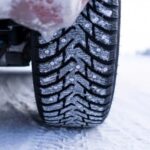
![What Are Snow Tires [Do You Need Them?] what are snow tires](https://roadsumo.com/wp-content/uploads/2022/10/what-are-snow-tires-150x150.jpg)
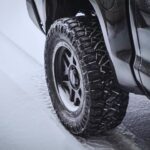
![Best All-Season Tire for Snow [Top 10 Tires] best all season tire for snow](https://roadsumo.com/wp-content/uploads/2022/10/best-all-season-tire-for-snow-150x150.jpg)
